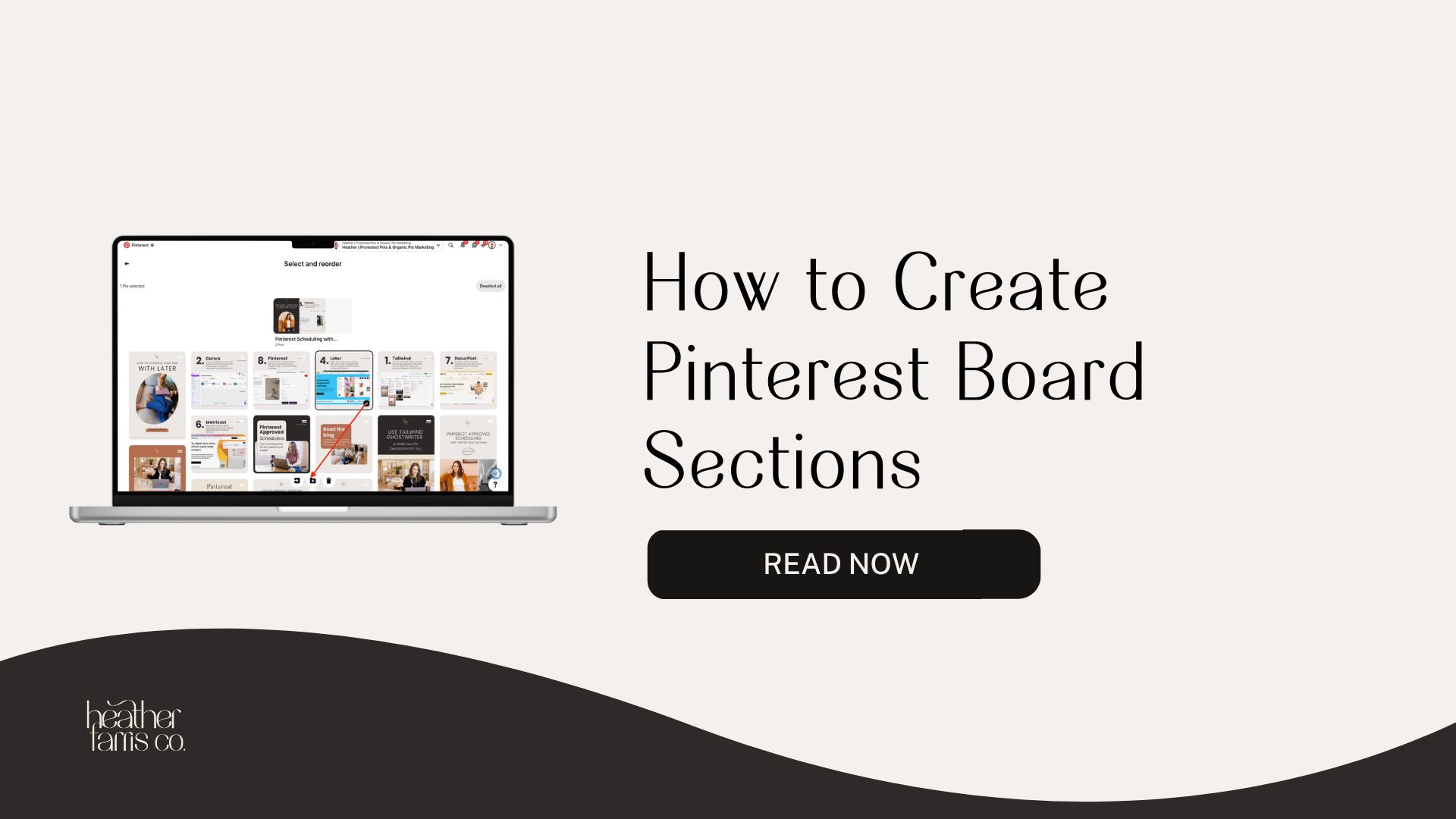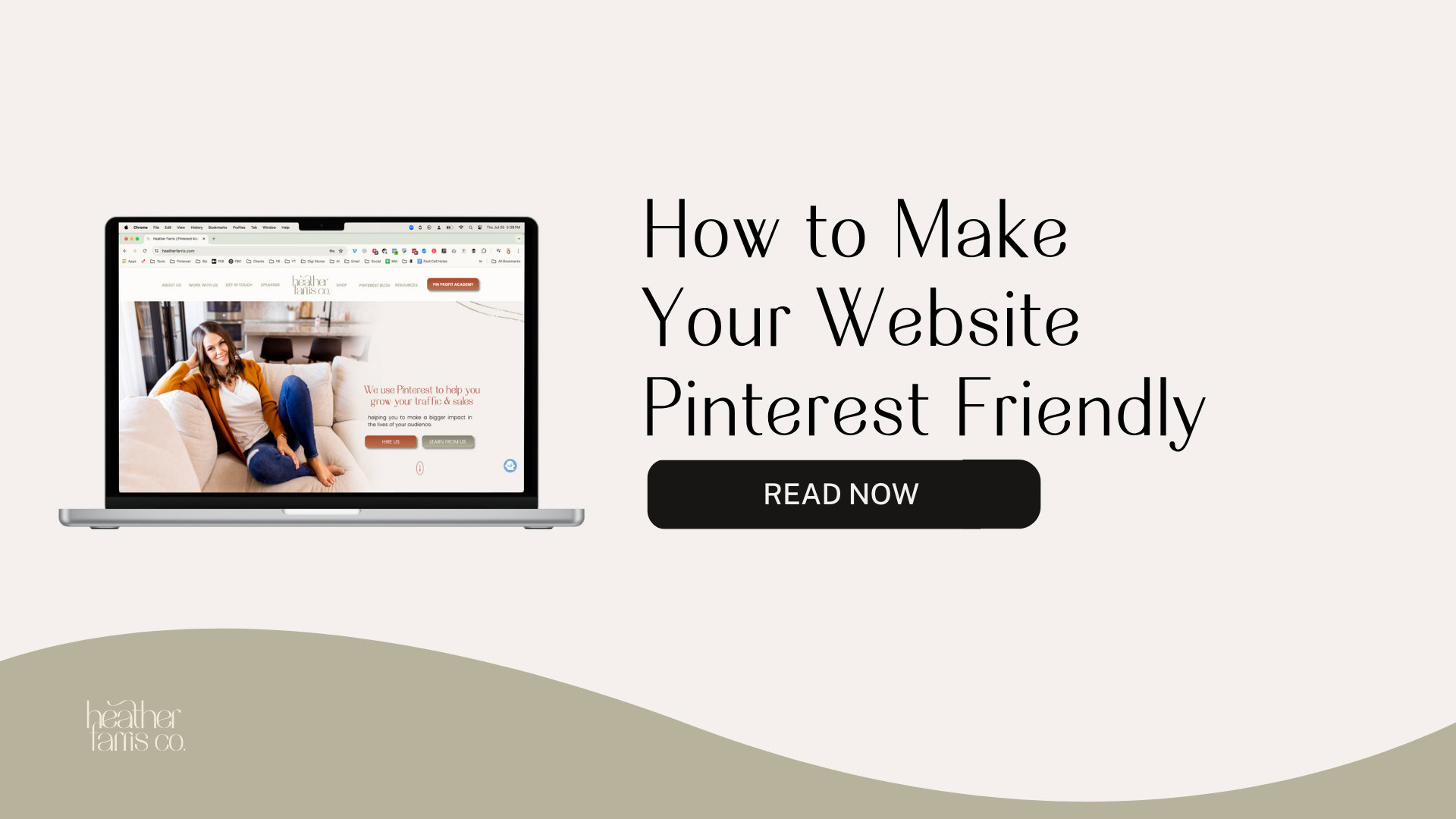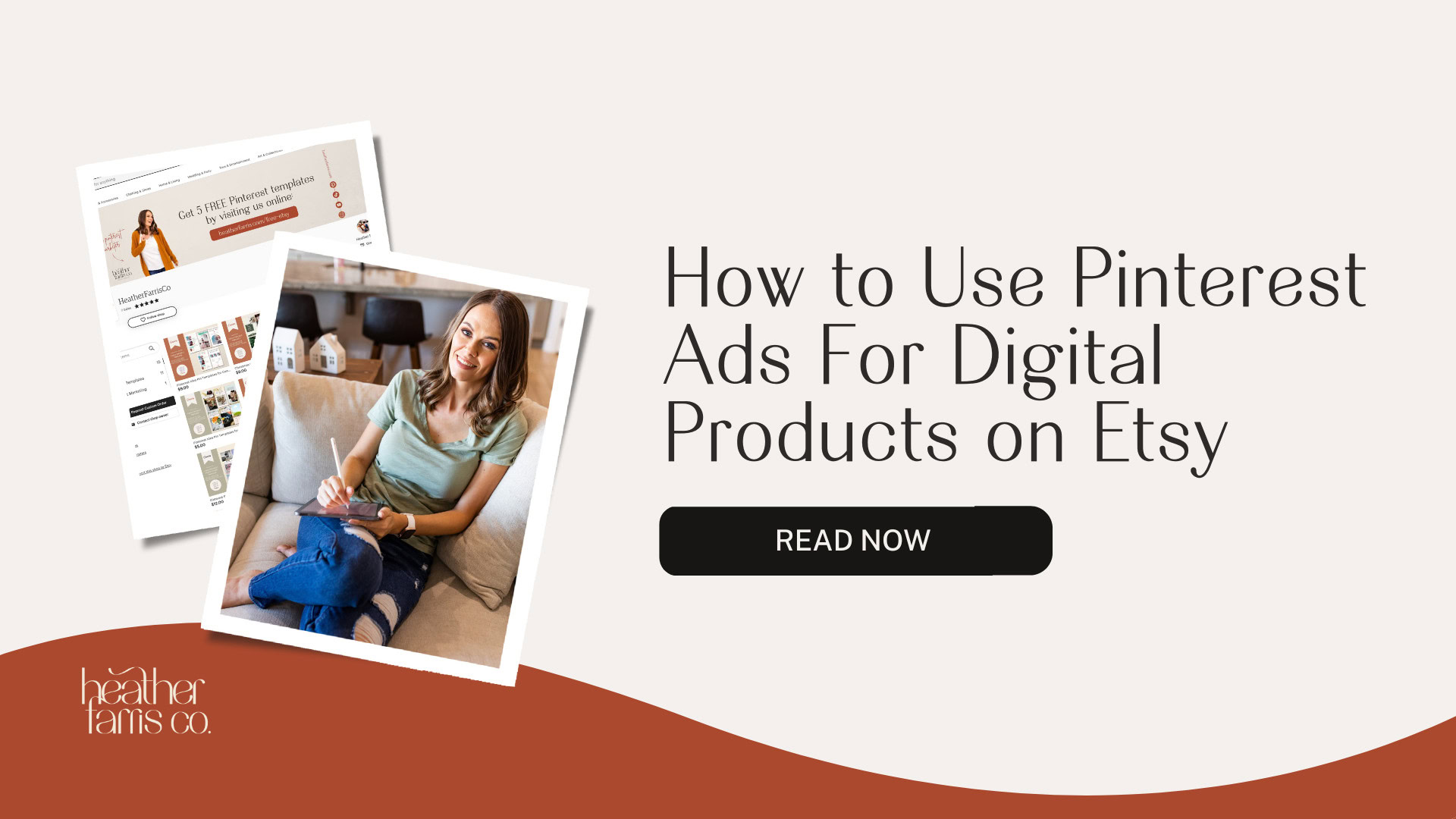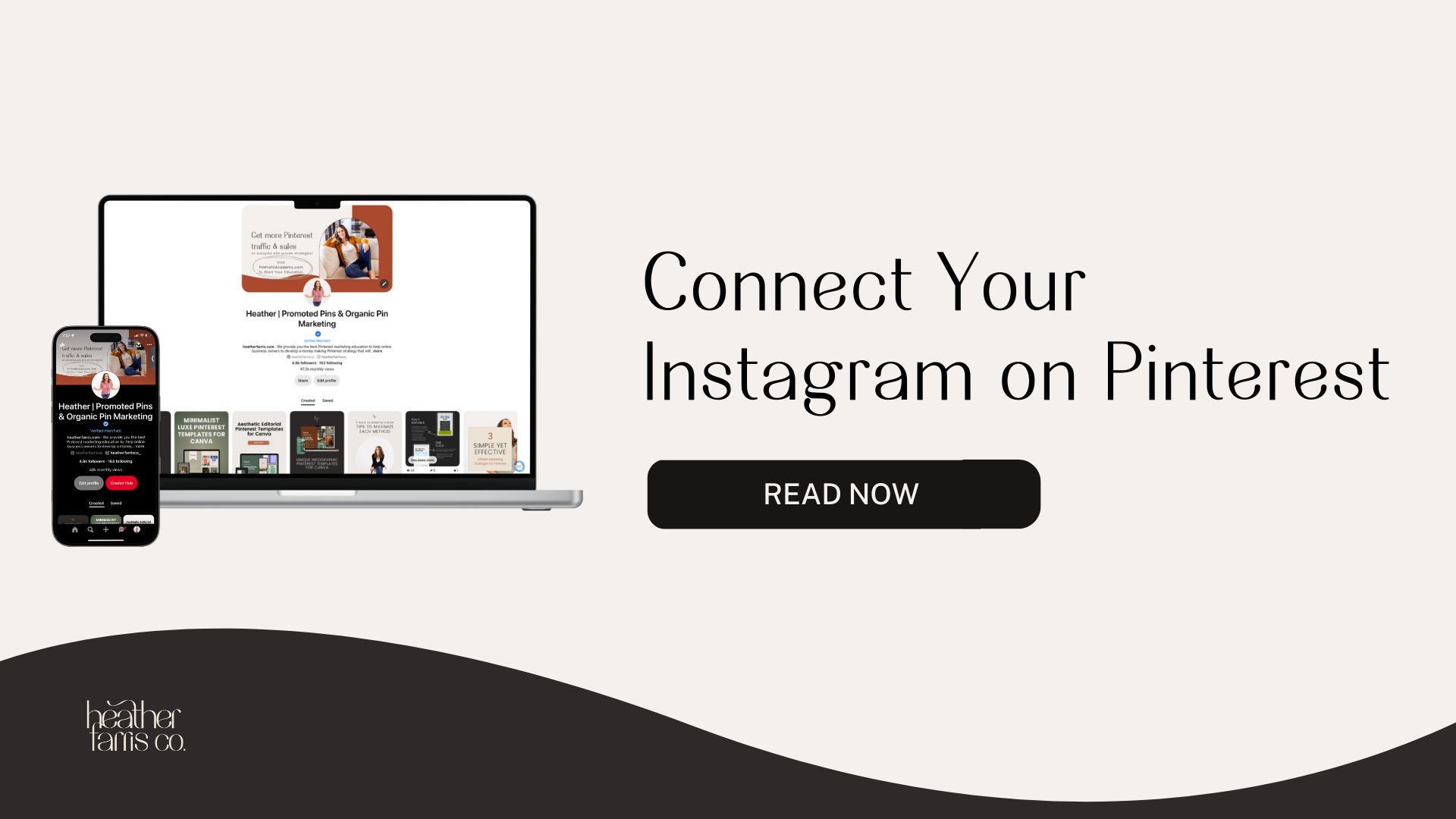Heather is a seasoned
Pinterest marketing expert & educator using the platform since you could reach the bottom of the feed - 2010.
About Heather Farris >
How To Do Affiliate Marketing On Pinterest With a Blog
March 17, 2024
Let’s talk about the strategies for affiliate marketing on Pinterest with your blog, your blog posts, and which type of posts perform best for affiliate monetization. Creating an affiliate marketing strategy for Pinterest users is slightly different from one you would create on Instagram, TikTok, or other social media because it’s a search engine.
I’ll also share the best tips that you can use and utilize in your affiliate marketing strategy to make the best money for small businesses, and provide the best value to your readers and watchers. If this is the first time you’ve done affiliate marketing for your Pinterest, you’re in the right place to learn and apply these transparent marketing strategies.
What to know before affiliate marketing on Pinterest
Most pinners on Pinterest are actually browsing for completely selfish reasons. They are not usually on Pinterest shopping for things like they are if they run across something on TikTok.
For example, this last week, I was browsing TikTok and saw a creator utilizing a clothesline in their backyard to hang their clothes. I live in the desert, and it’s very hot. We have almost 300 days of sunshine yearly, so a clothesline makes sense to me.
I have been planning to add a clothesline to my backyard for our pool needs, like our wet towels and swimsuits. By putting this piece of content on TikTok and telling me about how great it was, this creator encouraged me to go ahead and make that purchase I already had in my mind months ago. I had the idea of adding a clothesline for pool season back in the spring, but I had forgotten about it. So, it was an impulse purchase.
On Pinterest, Pinners are not there for impulse buying but for planning. Sometimes their planning and purchase journey could be as long as six months or more. But the average time is usually about 18 days.
The journey for our viewer on Pinterest, is going to be different from what we might create on Tiktok or Instagram. So there are different kinds of best practices that I’ll go over here.
RELATED: How to Use Pinterest for Affiliate Marketing
Best types of blog posts for affiliate marketing on Pinterest
Let’s talk about the types of blog posts that are best for affiliate marketing on Pinterest. I’ll also show you examples of each that work well for your Pinterest strategy and your blog.
When it comes to creating content for your blog with Pinterest in mind, there are four distinctive types of blog posts that I would suggest that you make.
- How-to content
- Reviews
- Comparisons
- Listicles
Now let’s talk about each of these different ways to use these blog posts.
RELATED: The Ultimate Pinterest Traffic Strategy for Bloggers & E-Commerce Shops
1. How-to content types
The very first blog type is how-to content. How-to content is going to teach people how to do something. I have two examples lined up for you, one of my own about Tailwind, and one of someone else’s that I went out and found about cast iron pans.
Tailwind tutorial leading to my affiliate link
For example, in the blog post about Tailwind and how to use it, I am walking you through the key features of using Tailwind to schedule your Pinterest pins.
I dialed into one specific how-to use case in this blog post: how to schedule pins. Tailwind talks about and allows you to do so many other things, but I have narrowed my focus on this one thing.
In this Tailwind blog post, I showcase how to actually schedule your content using Tailwind. Then I go into a free offer I have created where I tell people about this automation guide, so I can get them on my email list. That’s more of an advanced topic, where I talk about these three advanced strategies for affiliate marketing videos.
Then I have an affiliate funnel behind that where if someone were to grab the Pinterest automation guide, they are going to get into a newsletter sequence, and I am going to nurture them to get one of the scheduling tools I talk about.
Even deeper into the blog post, you will see me talk about my Pin Profit Academy. Here I am telling people I have a full automation course where I will teach you the ins and outs of each scheduling tool.
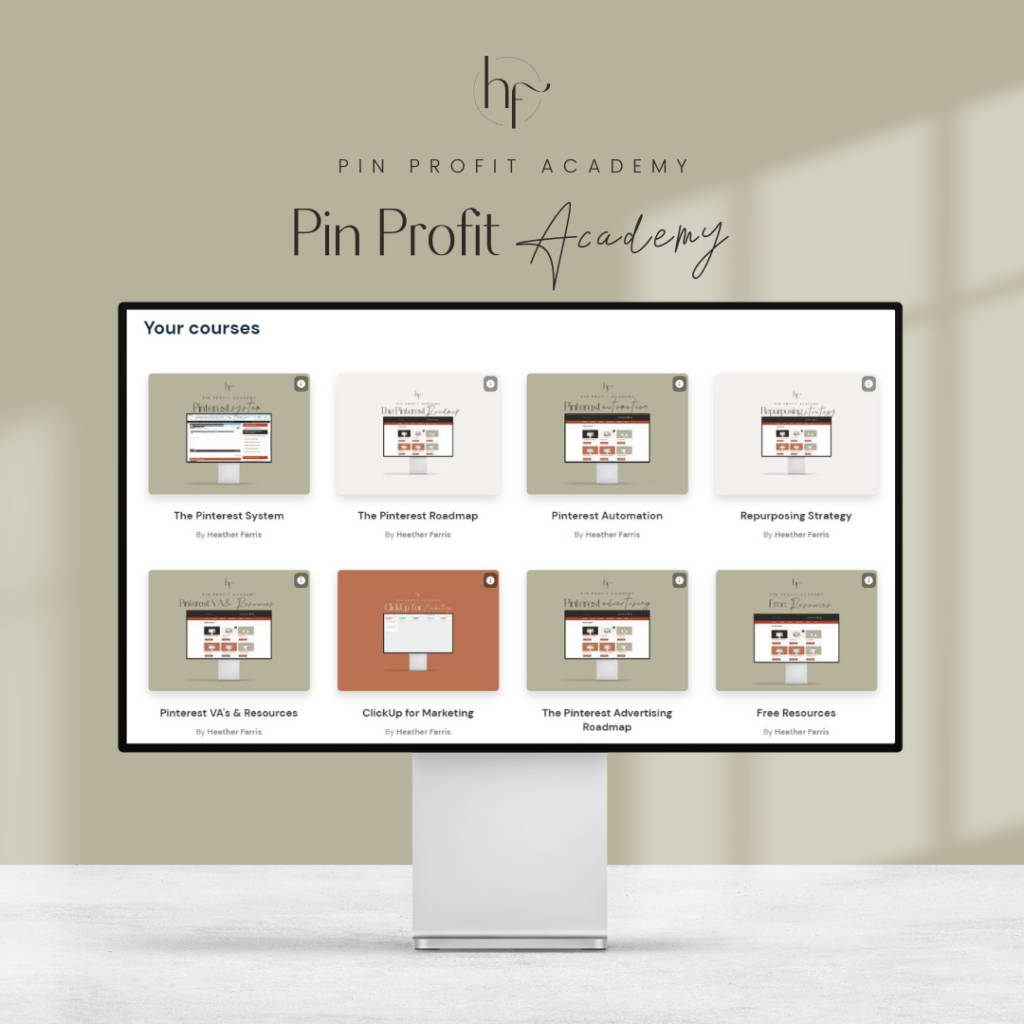
Pin Profit Academy
Marketing can be difficult and trying to figure it out on your own, especially with Pinterest, can be overwhelming.
I will show you how to double your traffic and sales without spending another minute on social media!
PPA is the only comprehensive membership program & community for creating, marketing & selling your products & services using Pinterest.
So you can go as deep as you like or as shallow as you would like in these how-to content blogs, but the bare minimum here is to make sure you create enough value and teach people how to do something with that tool, and you are not just glazing over all the details.
RELATED: I Tested Pinterest Approved Schedulers So You Don’t Have To
Cast iron pans blog example
In this example from a stranger on the internet, they will show you how to clean a cast iron pan. This is an example I use quite often. I often use cast iron pans in my life, so this is easy for me to talk about. Pinterest images that go to to a how-to post like this is great for affiliate marketing on Pinterest.
Cast iron pans are not your easy run-of-the-mill toss-it-in-the-dishwasher type of pan you can cook with. So, when it comes to cleaning them, if you want this piece of equipment or tool in your kitchen to last a lifetime, like the ones I inherited, you want to take care of them properly.
This content creator has a whole blog post teaching you exactly how to clean your cast iron pan, to use soap or not to use soap, to use scrub brushes or not, and soak or not. She goes through all of these details in depth.

Throughout this blog post, she linked the cast iron pans that she suggested you purchase. There are a few different options she provides. This is a great way to show someone how to do something with a product that you love, and then monetizing it with an affiliate link.
RELATED: 5 Ways to Monetize A Blog in 2022 + Tips to Maximize Each Method
2. Review blog posts
The second type of blog post you want to create is a review blog post. This type of blog post will thoroughly review a tool or a product in detail. You will review the pros and the cons and what did you like, what did you not like.
Be honest with this and go in-depth in your review. Review content will help people who already know that they want a product, but may want a little more information to help solidify their decision.
Even if your reader disagrees with your preference in the review, still linking to all the products and pinning those options is important for affiliate marketing on Pinterest.
Reviews I’m looking for and have done
For example, I am in the market for a high-end astro-photography telescope. I recently went on the internet and started reading review blog posts about these telescopes.
- What capabilities do they have?
- What accessories will they need to make it work?
- Did people like it?
- Were people able to achieve the imagery I want with the same tool?
So, I encourage you to create honest review content on your website and in blog posts.
In this one I did, I reviewed ThriveCart for selling digital products. Throughout this post, I talk about the things I love, the features I like, and the ones I think could be improved upon.
RELATED: ThriveCart Review 2023: Sell Digital Products Like a Pro
Cast iron pans review post
In this example that I found on the internet, this person is reviewing Le Creuset cast iron pans. This review post is actually really good. It goes into detail as to why these pans are so expensive but really actually worth your investment if you want pans that will last you a lifetime, that you can pass down to your children and grandchildren.

So, take a peek at these two reviews, and you can see the differences between how I structured it and how someone else structured it.
3. Comparison content
The third blog content type that I suggest you create is comparison content. Comparison content is going to lend you credibility. You need credibility and trust in order to sell to people on the internet who have never met you before.
Comparison content is great, and it shows that you have done your own research when it comes to the products that you are recommending. You’ve tried other things.
Comparing Pinterest schedulers
What I have done on my website and my YouTube channel is compare Pinterest Schedulers. This is great for people in my industry because they always want to know if there is a better tool that might be able to fit their needs for a better cost or with more features.
So in this piece of content I created almost two years ago, I tested Pinterest schedulers so you don’t have to.
- I go into detail on five different schedulers
- I list the pros and cons of each
- Explain six key points for each scheduler if I were to recommend it to you
It is a very unbiased review because I have used all of the products in the post over time. I have canceled and resubscribed to every single one of these over time. And I recommend all of them to you in different instances.
Comparing different brands of cast iron pans
In this other example, we have more cast iron pans. This person is comparing Le Creuset with Staub. They are comparing two high-end cast iron brands and telling which one they prefer.

So, in this blog post, you can see the difference between the Le Creuset and the Staub brand and the recommendations for each. Pinning this blog with different pins suggesting both the products are the pick, can be great for your affiliate marketing on Pinterest.
4. Listicle posts
Now the fourth and final blog post type that I suggest that you make is a listicle. Listicles are a list of different items that you recommend within a particular product lineup.
Listicles are great because they provide options for your reader, while still creating affiliate income for you. I even see food creators creating listicles out of recipes. You will see all the time on Pinterest, pins like “39 chicken recipes for the grill,” or “15 Recipes to use up the strawberries in your refrigerator”.
Lists for traveling in an RV
For this example, we are going completely out into a different website I own. This particular blog post actually brings me several hundred dollars a month in affiliate sales from Amazon, and I have not touched this blog in almost three years.
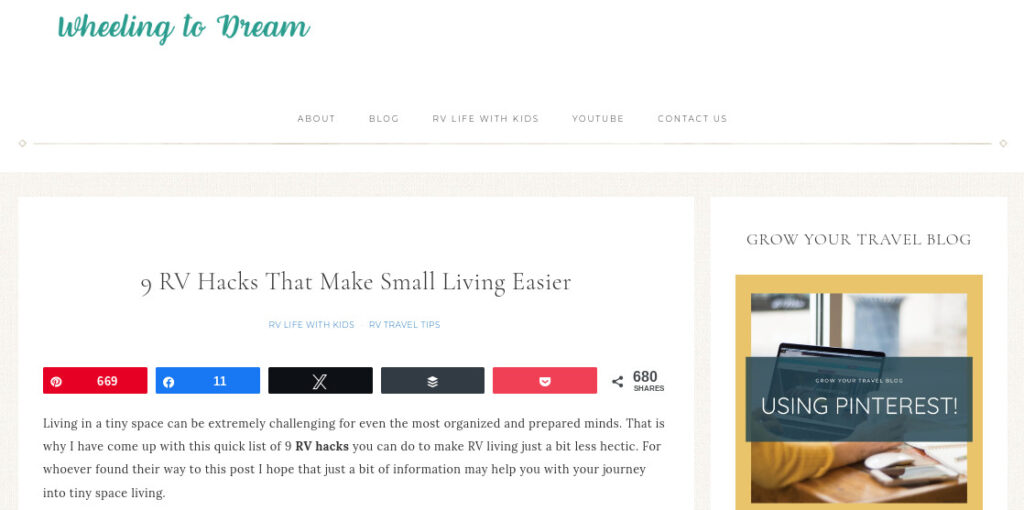
So, in this post on my travel blog, there are nine different products you need for RV living when you first start with RV life.
They are things like water valves, tire chalks, etc. and these nine things are going to make your life easy. With each of the nine things that you can see that I have added a blurb about each of them and how we use them.
I link to each of these nine things with my affiliate links. From here I could make pins for affiliate marketing on Pinterest with pics of all these different items. Lots of possibilities even in travel niches.
RELATED: The Complete Pinterest Marketing Strategy I Would Tell My Friends in 2024
Cookware list options for cast iron
Now in this post, according to a stranger on the internet about cast iron cookware, these are the five different brands that you should consider if you are looking to invest in this type of cooking tool.
As you browse through the post, you will see the different brands and the different things each brand offers, as well as probably a bit of a review about each one. However, it is a listicle showing different items within the same group of products from different brands. And that’s what really makes it great.

It doesn’t have to be all cast iron skillets; it could be the five face moisturizers you love to use throughout the year, or the home decor you love. If you are a dude reading this, it could be the five tools that you have to have in your toolbox to renovate a bathroom. It can be so many things.
RELATED: 5 Types of Content Creation You Need to Generate More Sales
What goes into creating a really great blog post for affiliate marketing on Pinterest?
So now that we have talked about the types of blog content you can create for great affiliate marketing opportunities on Pinterest, let’s talk about the four things you need to know when it comes to creating an affiliate marketing strategy that actually makes money.
- Be authentic with your readers
- Not going too deep into the details
- Build trust with your content
- Have fun and don’t lie
Keep it real
You have to be honest, and you have to be authentic. I hate the word authentic these days, but it is true. You have to be honest, and you have to be real. People do not want to see you creating content for the sake of hawking a product just for a sale. They can see through your content that you don’t like and you don’t use.
There’s one influencer that I watch on Instagram. She’s a well-paid fashion influencer, probably makes millions a year. I can always tell when she is doing a deal just for making money from it, instead of when because she loves the product.
How do you keep it real? You do it by sharing the struggles that led you to that product and what you love AND hate about it. You can be real about these companies and products while being constructive with your criticism.
Also, part of keeping it real is keeping your content cohesive with what you do. What I mean by this is if you are a make-up or fashion blogger, you are not writing reviews about Tailwind for marketing. If you are a travel blogger, you are not writing articles telling people how to do makeup. You are doing make-up reviews, fashion reviews, get-ready-with-me kinds of things.
Keep your audience in the forefront when creating content, which will help ensure that what you are creating for them is real. Don’t confuse them.
RELATED: My Simple Content Strategy For Digital Products
Don’t go too deep
Don’t go deep into every single feature and every bell and whistle about the product you are reviewing. If you are doing review-type content or how-to content, be focused and go deep into the specific features and the bells and whistles that you love.
But you don’t have to cover a tool from start to finish or make-up from start to finish with every possible thing that you ever do with it. Don’t fall into that trap. Be detailed enough to add great value, but not so deep you lose your audience in the weeds.
Build trust and credibility
To do this, you obviously need to be real. You obviously need to be providing value for your audience. I am not talking about just giving them three tips, and that’s the value that you give.
They need to be able to walk away from your content, understanding how they can solve their problems better and how this fits into their lives. And yes, you can even do this with affiliate marketing on Pinterest with your blog content.
So building trust and credibility is going to take you a long way. It will take people from not knowing you to purchasing through your links.
- You do this by creating comparison content, as we talked about earlier when I was creating comparison content for the schedulers.
- You do this by reviewing products and services and actually giving your real honest thoughts and reviews.
- You can talk about the products’ downside, the things you don’t like. As long as, when you are doing those things, you are providing some constructive criticism as to how those things could be improved.
- You do not just hate things that you hate. You are telling people you don’t want to buy this because of this or that reason.
- You are also not always making it sunshine and rainbows because that always feels fake.
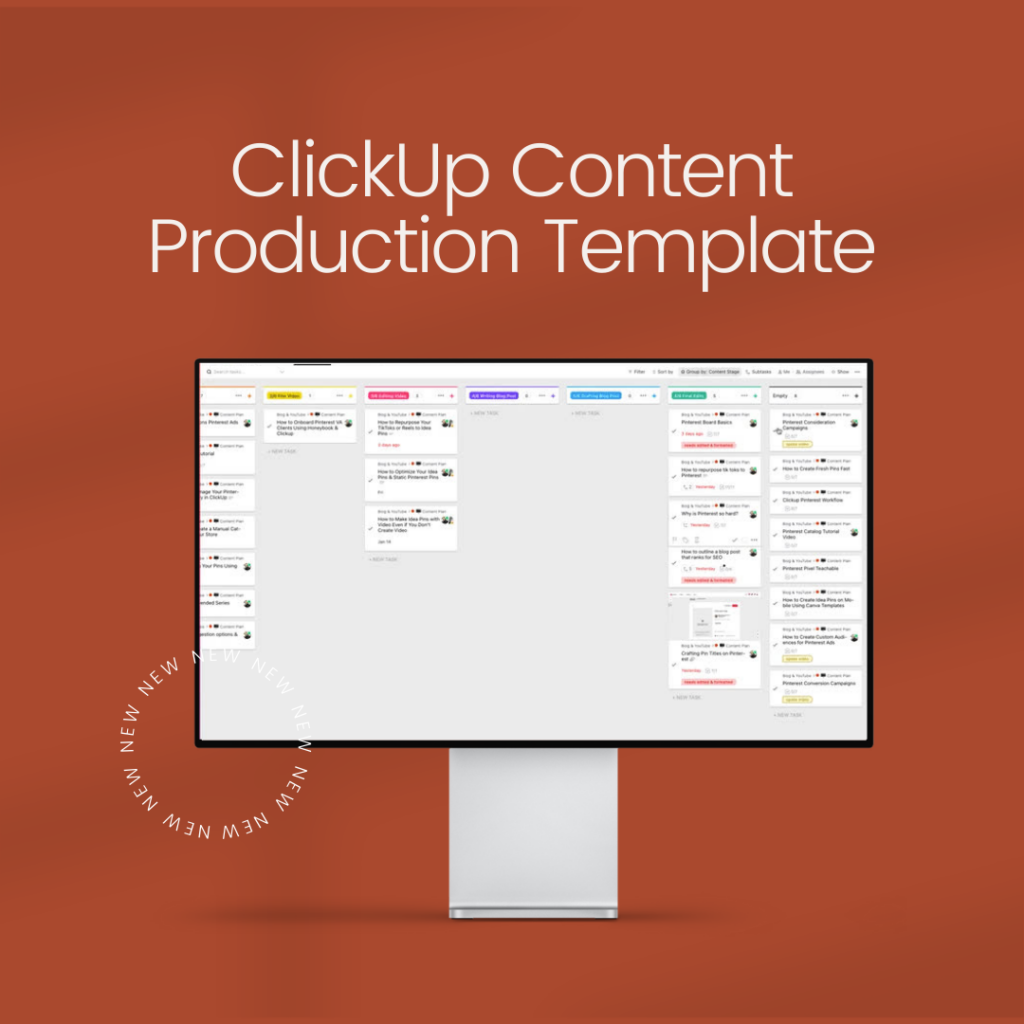
ClickUp Content Production Template
Produce high quality content each week without drowning in tasks with our ClickUp content production process & template.
This template can be used with the free version of ClickUp and is even friendly if you’re a beginner! You can completely customize this template to your needs.
You never know who is watching your content
The proof in the pudding. Right here, one of the co-founders of Tailwind, watched one of my YouTube videos right after they released Ghostwriter and commented on it. He said that if I needed anything, I could reach out to him. His credibility is that he helped to found this company I am reviewing for.

That has led to a great partnership with the affiliate manager at Tailwind. I am always getting their newsletter offers now. I am getting emails directly from her, where they are saying things like, “Hey, we’re going to run some ads to your video because it is a really good video.” Things like that! So you quite literally never know who is watching.
You can be talking about the downsides of products or the ways that companies can improve their products and services. But always keep in mind that you are doing it for the betterment of everyone else who can use this too.
Not only is that going to look authentic to your viewers, but it’s going to provide excellent feedback and a way that the company could improve its packaging, marketing, product, whatever it is.
RELATED: How To Get Traffic To Your YouTube Channel Using Pinterest
Have fun, and don’t lie
The fourth and final thing you need to do to create a very effective strategy for affiliate marketing on Pinterest with your blog is to have fun and don’t lie. There is so much garbage on the internet. You do not need to waste every waking minute trying to monetize every single thing that you do in your life.
You can have fun in your personal life, and you can do these things, and you can use these products. But that doesn’t mean you need to monetize all of them. At the same time, have fun with the ones that you are creating.
Final thoughts for affiliate marketing on Pinterest with your blog
Now that you know how to create affiliate content for your blog content and keep your Pinterest pinners in mind, one last thing is to head over to my playlist and watch these videos about affiliate marketing and Pinterest. I will see you there.
Pin it for later
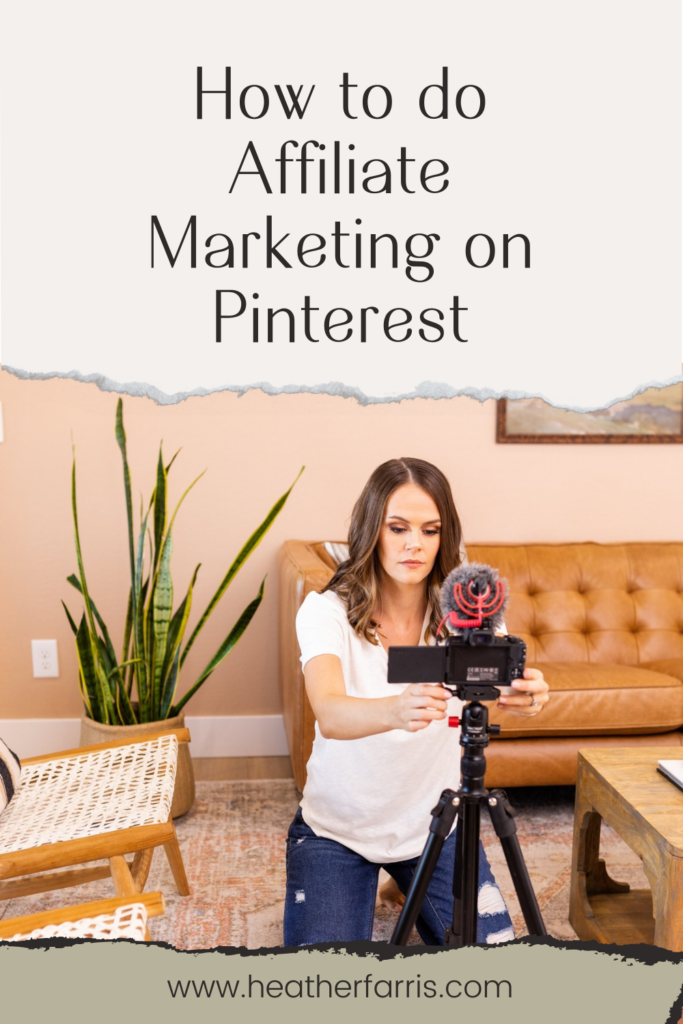

Heather Farris went to school for accounting and worked for years in banking and finance. After finding all of that entirely too boring she started her first blog in her basement in August of 2016. She has started 3 blogs in the marketing, motherhood and travel niches and used Pinterest to grow them all. She quickly became the go-to Pinterest strategist in her peer circles and has been implementing strategies, driving traffic and sales through organic and paid tactics for her clients. On this blog and her YouTube channel, as a renowned Pinterest marketing expert, she educates the public about clear and transparent marketing strategies to help them to grow on Pinterest and in other places online.

